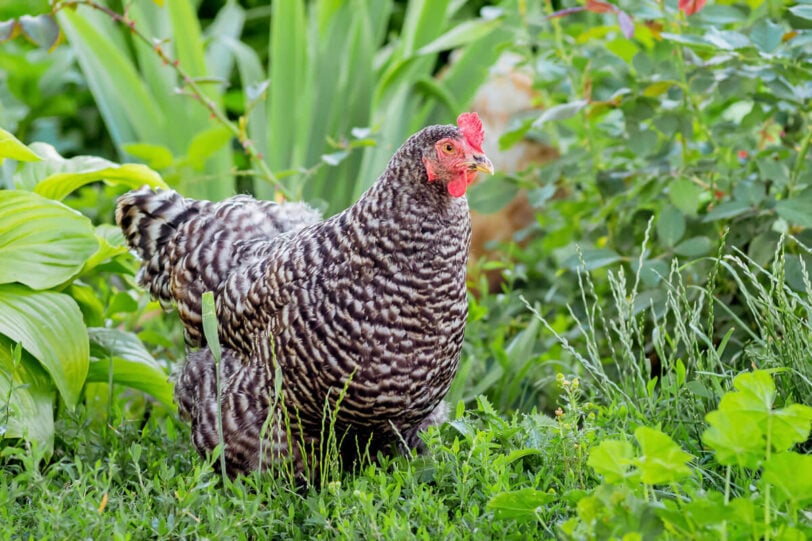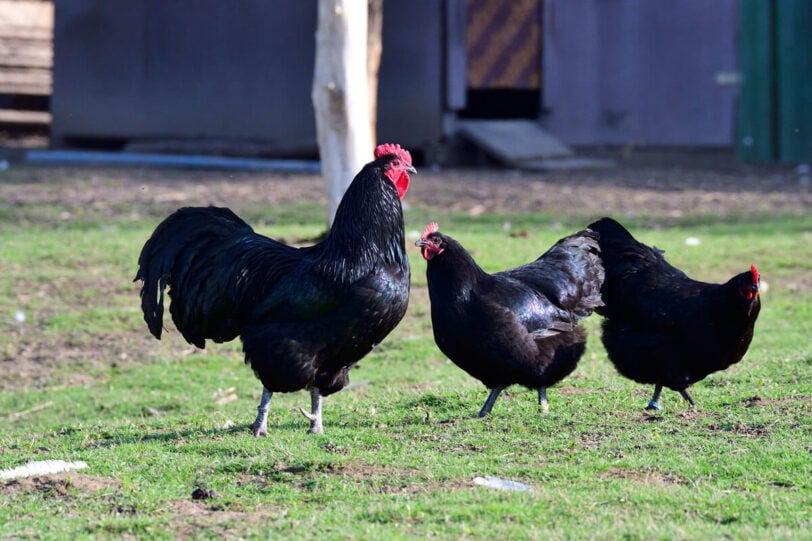With all the many, many wonderful chicken breeds out there, it can be hard to know where to start in choosing your first one. In this article, you’ll learn about five of the best chicken breeds for backyard flocks, and also get some helpful tips on knowing which one is right for you.
Rhode Island Red
The Rhode Island Red is one of—if not the most—iconic and popular chickens in the world, and there are many reasons for their dominance. Practical homesteaders are attracted to their versatility as a dual-purpose bird and steady egg production—a heritage Red will lay about 200 eggs a year, while a more modern production strain will average closer to 300 large brown eggs at their peak.

More romantic chicken keepers love the Red for their bright red feathers and bold, brassy personalities. These hens can be pushy and even aggressive with other hens, but they’re generally docile and friendly with their humans. Rhode Island Reds, especially heritage (read: older) strains of the breed, are also noted for their longer periods of egg productivity.
The Rhode Island Red was first bred in the 1850s and originated in Massachusetts and, of course, their namesake Rhode Island. Because of their New England origins and intended purpose as a homesteader, they are very hardy and relatively low-maintenance birds.
Delaware
The Delaware is a useful, dual-purpose heritage chicken breed that is actually on the verge of extinction, but this is more of a commentary on how industrial chicken farming has evolved and shaped the needs of farmers, than on the bird itself, which is a wonderful homesteader.

Although they are now considered a dual-purpose bird, in the 1940s and ‘50s, the Delaware was the dominant broiler in the American chicken industry. They were phased out in the late ‘50s and ‘60s as newer, larger, faster-growing breeds were introduced, and their popular decline was so dramatic that the breed remains endangered 60 years later.
However, the very things that led to their decline as an industrial broiler chicken are the same characteristics that recommend them to modern backyard chicken keepers. In addition to their delicious meat, the Delaware lays up to 300 large brown eggs a year. What was a waste of energy in their industrial broiler days has made them doubly useful to have in a small flock.
Plymouth Rock
The first thing to mention about the Plymouth Rock is their striking and unique appearance, specifically the black-and-white striped feathers that gave the breed its original name, the Barred Plymouth Rock or Barred Rock. While other colors have since been bred into the breed, this barred appearance is still the most iconic and sought-after color for the breed, and some will argue the only true representation of a proper Plymouth Rock.

Colors aside, the Plymouth Rock is a supremely useful bird—so useful, in fact, that it was the most popular breed in American history until the end of World War II. As this popularity would suggest, the Plymouth Rock is a hardy, low-maintenance bird. They lay about 250 large brown eggs every year, but are perhaps even more notable for the large quantities of tasty meat that once made them a popular industrial broiler.
Best of all for family farmers and backyard homesteaders, Plymouth Rocks are relatively gentle, docile birds that will be easy for new keepers to start with, and great with kids.
More on Backyard Chickens
Wyandotte
The Wyandotte may just be the most versatile chicken breed there is. Small flock keepers like them for their reliable egg production—between 200-250 large brown eggs a year. They’re also noted as good broilers, and they’ll certainly produce a lot of meat. Because of the Brahma influence in the breed’s background, a Wyandotte hen can reach seven pounds, and the roosters can grow to up to nine pounds.

Because of their featherless legs and relatively dense, close body feathering, the Wyandotte is hardy in a wide variety of climates, even cold ones, and is also less likely to have problems with mites and frostbite than other birds with flashier feathers.
The exact genetic origins of the Wyandotte are unclear, although we know it was developed in the United States in the 1870s. We also know that a lot of different breeds were introduced into the Wyandotte bloodline over the years because they come in a truly stunning array of colors. The American Standard of Perfection recognizes nine standard Wyandotte colors, but the equivalent European organization lists 30.
The most iconic is the original color, now called silver laced, which features white feathers with a sharp black edge; the similar gold laced Wyandotte has red and black coloring. These unique colorings have helped make the Wyandotte incredibly popular as a show bird, especially in Germany.
Australorp
If what you’re looking for is raw egg-producing power, then we’ve definitely saved the best for last. The Australorp once held the world record for most eggs laid in a single year, with one enterprising hen in the bird’s native Australia laying 364 in a single year in the 1920s. That record has since been topped by more productive modern hybrids, but the Australorp’s historical dominance remains a key part of their appeal.

For one thing, though less productive in sheer numbers than their descendants, a healthy Australorp will lay for longer than a modern hybrid breed. Additionally, because they were bred for small farms in the early days of white Australian settlement, they are good broilers as well; they also stand up well in almost any climate you put them in. Plus, their friendly, gentle nature makes them easy to fall in love with as a family pet.
How to Choose Your Chickens
Choosing your first chicken breed is a bit like choosing a wedding dress or a new car. It’s easy to let your head get turned by flashy colors, unique histories, or sky-high egg production numbers, but that doesn’t mean that you’ve found the right hen. However, with time and careful thought about what you actually want, you can be certain that you’ve chosen exactly the right one.
When choosing the breed of your first flock, the most important things to keep in mind are what you need and desire in a flock. If you want to make your first shortlist by writing down every bird you fell in love with while browsing, that’s a good start, but then narrow it down by considering:
- what climate the birds will thrive in,
- how easy they are to handle for the level of experience you have, or if you have children,
- how prone they are to certain diseases and health problems,
- how many eggs your family or business will actually need, and
- whether or not you desire to harvest meat as well as eggs.
You may also be limited by price and local availability; even classic breeds like the Delaware can be hard to come by these days.
Most of all, remember that choosing one breed now doesn’t mean you’re married to that breed for all time. You can change or expand your flock as you learn more about keeping chickens and what you want from and for your flock.








